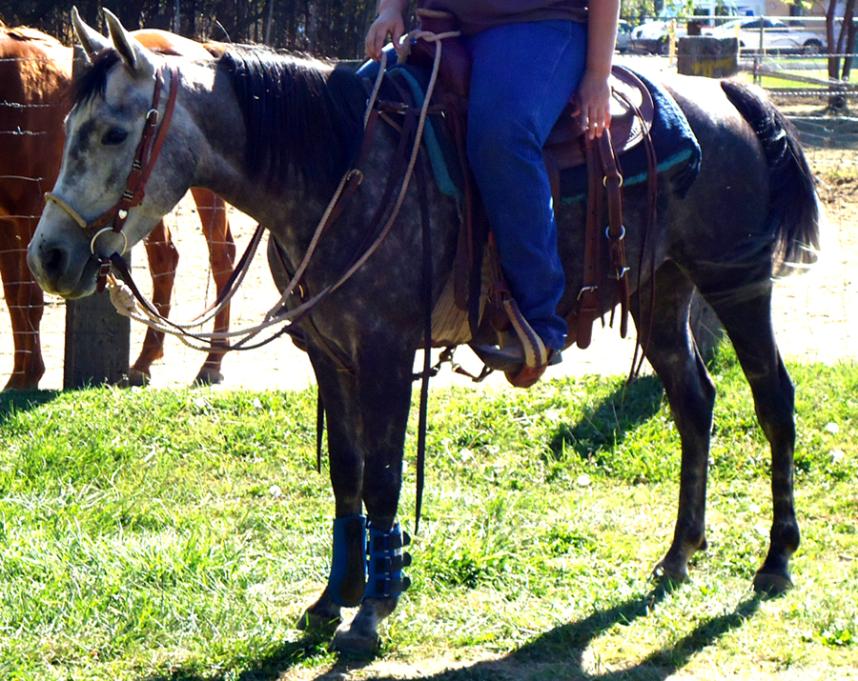
Saudii Fadmar
Pedigree Information
Saudii Fadmar is a 15hh
1050lb mare with a 78 inch heart girth and 8 ½ inch cannons. Outside of being a
broodmare, Saudii Fadmar has been
used as a ranch horse and a kids’ horse, working cattle, mountain riding, and
giving children their first rides on an Arabian. She has been exceptionally
strong in passing on her athletic body, with her wonderful shoulder and her
powerful hind quarter to her foals. Saudii
Fadmar is by the Endurance producing stallion Kioraja. He was
15.2hh and had a very sweet temperament to him. Kioraja loved children, loved to be ridden in the mountains, even
with mares right beside him he was a gentleman, and had a finesse with the
mares. He would sweet talk the mares and was so careful with them, to the point
where no mare wanted to leave when it was time to go home. Kioraja was known in Utah for producing
fantastic Half Arabian Endurance individuals. Of all the foals he produced,
only 4 were purebred Arabians. Saudii Fadmar was the last foal Kioraja
produced before his untimely death from Colic at just 16 years of age.
Kioraja is by Saable.
Saable was a 16hh black stallion
that had a commanding presence about him. When his owner brought him out to
present him, everything in the barn stopped to watch him. Saable had numerous Championships in Halter as well as under
Saddle. Saable is an SX
Saladin son. SX Saladin was US & Canadian National Top 10
Stallion, Canadian National Reserve Champion Stallion, and Pacific Coast
Champion Stallion. SX Saladin is
full brother to SX La Quinta and SX Bint Cobah+++, Legion of Supreme
Merit. SX Saladin is by the great
Crabbet stallion *Serafix.
*Serafix was imported from the Crabbet Stud of England to the US March 29, 1954. *Serafix
was bought by John Rogers and brought to Walnut Creek, CA. Homesick for his
groom in England, *Serafix went off his feed. Mr. Rogers resorted to
nearly living in the stallion’s stall. Rogers would feed, groom, and feed *Serafix
and sleep in his stall between work hours and family commitments to gain his
trust. Time would bond the two together. From this effort, *Serafix and
Mr. Rogers would develop a lifetime friendship. When Mr. Rogers had to be away
on business for weeks at a time, *Serafix would greet him with knickers
of joy upon his return.
*Serafix was shown in 1954 at
the Cow Palace and at Pomona, California, winning Reserve Champion at both
shows. In 1955, shown by Bob Smith of the Kellogg breeding farm, *Serafix earned Grand Champion
and Champion Stallion at Pomona. In 1957 and 1958 *Serafix was only shown once
each year and was pinned Champion Stallion each time. He was never shown
again. *Serafix
became best known through his progeny. Mr. Rogers bred and showed most of
his own horses and he states that his biggest and best year of *Serafix’s career was in
1962. That was the year 4 of *Serafix’s
mares and 1 of his sons each won a Top 10 Ribbon. These winnings comprised
1/4th of the 20 Top 10 ribbons of the Estes Park Show. Of those winnings,
there were: Chloette—National
Champion Mare; Fixette—National
Reserve Champion Mare; Silver
Dawn and Starfire
were Top 10 Mares; and Royal Magic was a Top 10
Stallion. Later on, Starfire
was lost to hepatitis, but Silver
Dawn went on to be twice Reserve Champion Mare, then National
Champion Mare. There were other mares such as, El Malika, SX Genii’s Pride, and Gioia that also showed
well. John Rogers may be the only person who still holds the longest
winning record of horses shown at the National level. He states, “One
statistic I kept in mind always, from the 1st National classes held in 1958
through the Nationals in 1974, was this: a horse of my breeding or ownership,
(most of whom were by *Serafix)
placed in the Top 10 ribbons at Halter in each year. Only 1 Top 10 mare in
1975, Overlook Seratifa,
was not owned by Mr. Rogers, but was of the Overlook Arabians of Nevada." (The Arabian Horse,
September 1976.)
*Serafix’s sire was Raktha, a British Champion in 1948 and sire of numerous Champions
and National winner producers. Raktha
was foaled in 1934 at the Hanstead Stud and was purchased by Lady Wentworth in
1939. Raktha and Indian Gold (sire of *Serafix's dam *Serafina) were regarded as 2 of
the most important stallions at the Crabbet stud during World War II. Raktha traces back to Naseem and Skowronek and was an extremely
beautiful dark dapple grey, slightly heavy in body, but still deserving of the
British Champion Stallion Title at age 14 in 1948. Raktha was regarded as being
very different in temperament from his sire Naseem. Raktha
was quiet and easy, a type of horse that was good to take to a show. This
stallion was regarded as one of the very few perfect types of Arabian stallion. (The
Crabbet Arabian Stud, Its History & Influence by Rosemary Archer, Colin
Pearson, Cecil Covey). Raktha
is also known for his progeny besides *Serafix,
such as his famous sons General
Grant out of Lady
Yules' Samsie, and Indian
Magic out of Indian Crown. His
famous daughters were Silverlet
(out of Silver Gilt)
who went to South Africa along with Bint
Razeena. Another daughter, *Silwa, is an American Halter
Champion and dam of 4 Champions. *Silwa
produced *Silwara, a
dam of 4 National winners including the Canadian National Champion Stallion Tornado++,
Legion of Merit. Other famous sons include *Silver Drift (full brother to *Serafix) and Indian Magic, a British National
Champion Stallion.
*Serafix’s dam was the ethereal mare *Serafina, a highly regarded mare of the Crabbet Stud farm of the
post-World War II era. *Serafina was foaled in 1945 and was considered
one of the great mares that led to the resurgence of the Crabbet Stud after the
war. *Serafina's sire, Indian Gold, was one of Crabbet's premier
stallions. Lady Wentworth's breeding program was rooted on the crossing of
the Mesaoud and Skowrenek bloodlines whenever possible. Not
all of Lady Wentworth's stallions were shown to gain notoriety. Travel was
largely by rail and to risk valuable bloodlines to injury or worse was not
worth it. One of those stallions that was not shown was Indian Gold,
being a tail male descendent of Skowrenek through *Raswan and Ferhan,
this stallion gained his value as a sire through his offspring and particularly
through his daughters. *Serafix was *Serafina's 1st foal and *Silver
Drift was a full brother, both were sired by Raktha and imported to
the US. *Serafina was over 15 hands which was felt to be due to
several crosses to *Nureddin. She was a brilliant, iridescent
chestnut which she bequeathed to *Serafix. She had very little
white. A quote out of The Arabian Horse, September 1976, an article by
Dick Warner, comments on *Serafina: "She is exceptionally good up
front with a very long neck, well joined on; good withers and a typy
head. She is elegant. She has a deep hip and good legs and a splendid
top line. In short, she is an excellent Arabian mare, with few obvious
faults of conformation or type." *Serafina was sold in 1960 to Mr.
S G Bennett of Georgetown, Ontario and foaled *Bright Gold in 1961. Mr.
Bennett continued breeding *Serafina on his Arabian farm and she was
later purchased by Mr. Paul Brown in 1970. *Serafina had her last
foal in 1972, she lived to be 31 years old and died July 12, 1976.
SX Saladin’s dam is the bay mare Cobah. Cobah was a World
Class producing mare having produced such greats as SX Saladin, SX Challenger++/,
SX Bint Cobah+++ and SX La Quinta. Cobah’s sire was Pomona
Ahmen. He was bred by the US Government Remount Service, is 50% Crabbet and
50% Spanish bred. Pomona Ahmen was
an incredible stallion and crossed well with Al-Marah Radames and Comar
Bay Beau+++ daughters. Pomona Ahmen
was by the Crabbet Arabian Stud stallion *Raseyn
and out of the imported Spanish mare *Nakkla.
*Nakkla was bred by Marquies de
Domecq, of Jerez, Spain, imported from Spain to the US in 1934 by James Draper
of Richmond, California.
Cobah’s dam is the 100% Crabbet mare Faradina. Faradina was
sired by the Champion Arabian stallion Farana
of Kellogg Ranch. During his short competitive show Career, he won a 1st or 2nd
in every Stock Horse class in which he was entered, against the best of
competition. He was Champion Arabian Stallion at the 1933 California State
Fair, also winning the Light Weight Stock Horse class. He was again Champion at
the 1933 Coronado National Horse Show, and the same year was Champion Stock
Horse. In 1933 Farana was 4 years
old. Soon competitors became disinclined to show against him and so he was
retired from competition – although he continued for years to give exhibitions.
Farana was a widely renowned athlete,
a 1930’s era Stock Horse, so phenomenal that he became a legend in his own
time. Herbert H Reese described Farana’s
work, saying that Farana showed
“speed and precision”, and “dizzying spins” with “electrifying response to the
rein”. Mr. Reese continued: “A spectacular worker, Farana was especially good at spinning, a type of showmanship
demanded of Stock Horses in those days to indicate their Reining ability, and
he could whirl so fast that he occasionally ‘spun’ right out from under his
rider. Farana slid to the straight
‘figure eleven’ stops as well as any low-headed Quarter Horse, with instant
take-off into a run when so indicated. Stock horses in those days also had to
work with the rope and he held the ‘calf’ with a taut rope at all times. Farana could out-perform all exhibition
Stock Horses of his day. He could also back faster than the average horse can
trot, and would back uphill out of the arena at Kellogg’s at a fast clip as a
finale to his performance.” Mark Smith, Farana’s
trainer, spoke of the extreme lightness of Farana’s
mouth, his willingness, and his phenomenal speed in responding. “One of the
fastest things on his feet I ever sat on,” he said. Faradina’s dam was the *Ferdin
and *Rossana daughter Hazzadina.
Saable is out of
Kashmiri, a Fadjur daughter. Fadjur was one of the
most-loved horses in Arabian horse history. Fadjur won many National
titles for his conformation and type, yet his most lasting contribution to the
Arabian horse breed is his prepotency as a sire of excellence. Fadjur's
influence transcends time and generations of exceptional Arabian horses with a
special charisma, intelligence, beautiful Arabian type, athletic ability and
wonderful disposition that is known as 'the Look of Fadjur.' Fadjur's
everlasting legacy lives on at his lifetime home through the blood of his
finest get at the Jack Tone Ranch in Stockton, California, USA. In 1999 Fadjur
was inducted into the Arabian Horse Trust Hall of Fame, for his influence on
the Arabian Breed.
Kashmiri was out of Marsaba,
a daughter of the Champion stallion Risab.
Risab was a son of Ronek, a product of the Kellogg Ranch
breeding program. Ronek was sold as
a weanling to P B Fouke, New York, New York, then sold again as a yearling to
General J M Dickinson. Ronek had the
ability to pass on his natural inclination for Gaiting, a natural talent and
ability that was recognized and brought out in him through enhancement training
while living with and standing at stud for General J M Dickinson’s Travelers
Rest Arabian Stud. In addition to his duties under saddle and at stud for
General Dickinson, Ronek was the
Champion Arabian stallion and winner of the Saddle class, Illinois State Fair
1937, and also a prize winner at the 1935 Arabian Show in Nashville,
Tennessee. Ronek spent the last of his days in Calabasas, California in the
company of the esteemed *Witez II,
dying in 1956.
Through Marsaba’s line Saudii Fadmar carries a line to *Mirage
through his daughter Ragia, again once through Gai-Adventure
through the daughter Rageyma, and lastly through Tailormade Bonanza
and Chivari through the son Image. Roger Selby’s main purchase in
1930 was *Mirage, an imported grey stallion, 14.2hh, 1000lbs, three
gated, sound, most gentle and lovable, of the Seglawi Jedran Dalia strain, the
most prized of the Seglawi strains. Lady Wentworth described him as ‘a very
showy good horse. Excellent legs, splendid quarters and fine front. Very good
in saddle, but too bouncing for English taste as he gets English riders off.’
But this was not the reason *Mirage was sold. Weatherbys had by now
closed their Stud Book to new imports and although Lady Wentworth tried to
persuade them to accept *Mirage, she was unsuccessful and therefore had
no option but to sell him. Margaret Lindsley Warden said of *Mirage:
“now rated by many experts as the most perfect specimen of the ancient elite or
classic type in America…He stands a scant 14.2hh, a sturdy model with the
characteristic refinements of the best of his breed. His head is a glory and
his great eyes express high but gentle spirit and gracious personality.” *Mirage
was English Champion at the Richmond Royal Show 1926, and American Champion at
the National Arabian Show, Nashville, TN 1934, at the age of 25. A most unique
honor for a horse of such remarkable age. Only one other horse, Mr. Selby’s
mare Champion Rifala, holds the same record of being both a British and
American Champion.
Kioraja is out of the Kiowan daughter, Kiorene.
Kiowan's sire was the *Naborr son, Gai-Adventure. A Sire
of Significance, Gai-Adventure was 1973 US National Reserve Champion
Stallion, 1974 US National Champion Stallion, US National Top 10 Pleasure
Driving. Gai-Adventure is half sibling to US and Canadian National
Champion Stallion *Aramus (*Naborr x Amneris), imported
from Michalow State Stud Farm, Poland to be the foundation Stallion for Wayne
Newton's Arabians and half siblings *Gwalior (*Naborr x Gwadiana),
Canadian National Champion Stallion and *Dornaba++, US National Champion
Mare and Reserve National Champion English Pleasure, Legion of Merit. *Naborr
is one
of 8 World Sires of Significance who have sons who are Sires of Significance. (*Gwalior, *Aramus, Kaborr+++,
and Gai-Adventure). In 1954 *Naborr was named Reserve National
Champion at the All Union Agricultural Fair in Moscow. (Winner of that class
was his sire, Negatiw.) *Naborr sold at age 19 for $150,000 and
in 1963 *Naborr was imported to USA by Anne McCormick, traveling on the
same boat with *Bask++.
*Naborr is by the great Russian stallion Negatiw. Negatiw was
bred by Tersk Stud, Russia. He was 50% Crabbet. Exported to Poland in 1962 and
was a race winner in Poland. Race record: 1/4 (2-0-0). Sire of many Race
winners. Negatiw's sire line was Ibrahim and his dam line was Gazella
DB. Negatiw was 1954 Russian National Champion Stallion. He was
credited as the stallion that returned the Ibrahim sire to Poland. Negatiw
remains highly regarded around the world as the most internationally
influential grandson of the immortal Skowronek. Though bred in Russia, Negatiw
was from predominantly Polish bloodlines as his dam was a Janów Podlaski
confiscate from the Second World War. As a considerably successful sire at
Tersk, Negatiw was greatly desired by the Poles for many years. He was
finally obtained at age 17, standing in Poland for another 10 years with
outstanding results. Having already sired international Sires of Significance *Salon
and *Naborr in the USSR, Negatiw left Poland with the immortal *Bandos
PASB and a host of wonderfully typey, ultra-refined and extraordinarily
feminine broodmares. Director Krzysztalowicz described Negatiw as
'extremely dry and refined, with a small, chiseled head accented by beautifully
large, dark and luminous eyes and small ears. His legs were relatively correct
(though slightly sickle-hocked) and his back and topline were strong and a bit
long. As a stallion, he was strikingly refined and distinguished - he
represented a rare example of perfection.'
Gai-Adventure is out of the Champion mare Gavrelle. Gavrelle was
bred by Daniel Gainey and was part of the Gainey’s Gold Cross with Ferzon and
the Rageyma daughter Gajala, and helped perpetuate the Gainey “look”. She was a
beautiful dapple grey, was exported from the US to Paraguay in 1982 and
continued having foals. Gavrelle was
a Champion mare from 1957 to 1962. Gavrelle was sired by the great stallion Ferzon.
Ferzon was bred by Frank McCoy and
foaled at the same time as Fadjur on
the McCoy Ranch. McCoy listed both stallions for sale with Fadjur's price at $700 and Ferzon's price at $10,000, not
dreaming anyone could come up with that kind of money during that time. McCoy
then showed Ferzon in 1953 at the Palm Desert, CA First Annual All
Arabian Show to Reserve Champion Stallion. At that same show Ferneyn, Ferzon's
sire, took Grand Championship. Moneyna, the dam of Ferneyn,
was named Reserve Champion Mare, while Hasa, a half-sister to Ferneyn
by Ferseyn, was the Grand Champion Mare. That same year Ferzon
also won the Long Beach, CA Yearling Colt Championship, San Diego, CA Desert
Arabian Association Yearling Colt Championship (again he placed 2nd to his own
sire Ferneyn in the Stallion Championship). In August of 1953 Ferzon
was Reserve Champion Yearling Colt with Fadjur
placing 4th. In September of 1953 Ferzon was the Champion Yearling Colt
at the Los Angeles County Fair. Then came Daniel Gainey, Sr, with $10,000 to purchase
Ferzon and to produce a distinctive look to Arabians that many people
now call the Gainey-look. One of the most popular teams of horse and
rider ever, Harvey Ellis and Moneyna
were famous for his exhibitions of riding her with no bit, no headstall, no
head equipment of any kind. Among their many show credits were Champion Mare
and Grand Champion, Pomona 1948 at 11 yrs old, and Reserve Champion, All-Arab
Show Palm Desert 1953 at 16 yrs old.
Moneyna
traces in tail female to the famed war mare *Wadduda. Saudii Fadmar carries
9 crosses to *Wadduda. *Wadduda was presented to Homer
Davenport as a gift by Achmet Haffez. *Wadduda
had been for several years the favorite personal mare of the Hashem Bey, and a
gift of him to Achmet Haffez. On Davenport’s first meeting with her, ridden by
Ali, eldest son of Achmet Haffez, in a moment into the courtyard she came
tearing towards them, all afire, bouncing tassels, blue beads in her highly
carried tail, such hock action, and her eyes fairly sparkled. Her name in
Arabic has meaning of love/affection. Achmet Haffez in an emotional voice said
that when you speak her name it shall bear witness of his regard and the gift
and acceptance will be the foundation of their friendship and brotherhood
without end. A child of the desert she was. It is said that she did not seem to
like the confines of her life in town. Davenport recounts the evening of their
departure from Aleppo, he riding her. Over the dirt and rocky road they rode,
she fretted. Davenport felt that perhaps it was the strange rider and clothes.
Then just at sunset, they came to the edge of the desert. *Wadduda stopped, as if paying tribute to the closing day. Salat
Al-Maghrib, sunset prayer. Then, with a quick toss of her head she began to
cavort and play. He settled deep in the saddle and let her frolic. Finally, she
stopped short, snorted, and broke into a gallop with a delightful spring. It
was a return home for her, the call of the nomadic life, of raids and races,
open air under the canopy of stars, as opposed to the confines of her corral in
town. Ears alert, she pranced, eyes blazing with intense satisfaction. Davenport
said that during this, he too had been carried back to his boyhood dreams and
fantasies, was surprised to find his cheeks wet; he had been crying without
being aware of it, realizing then who and what she was and what she meant to
him. Such was the true *Wadduda,
mare of the desert. One of *Wadduda’s
famed exploits was a ride in pursuit of a caravan from Iskanderoon to Aleppo,
some 106 miles in 11 hours (a feat equal to The Tevis Cup Ride in time and
distance) and prior to that feat to have had a pastern damaged in war/raid; she
is also recorded as bearing lance wound scars on neck and shoulder. Gladys
Brown Edwards of *Wadduda states
that perhaps plain headed she may have been, but she was neither coarse nor
common, and was a mare to be proud of. ***from *Wadduda
‘The Great War Mare’ by Jack Kenning
Kiorene’s dam Charene is by the Garaff son
Garene. Garaff was a Halter and Performance Champion, a Champion
in Western Pleasure, a blue ribbon winner in English Pleasure and Native
Costume, and is sire of 5 National winners in Halter and Cutting. He was a well
trained ranch horse who did Roping and Cutting as well.
Ferzon's dam, Fersara,
was Pacific Coast Champion Mare 1952, 1953 and Reserve Champion Mare 1954.
NEVER OUT OF THE RIBBONS - 27 Classes (21 Blues). 3 time Grand Champion -
Pomona Fall Show. Permanent Winner - Kellogg Challenge Trophy. Fersara
was considered The Champion Mare, and was Always The Horse To Beat.
Saudii Fadmar
carries many lines to the Crabbet stallion *Raffles. *Raffles was
bred by Crabbet Arabian Stud, Sussex, England, was imported from England to US
in 1932 by Roger A Selby, Portsmouth, Ohio. (*Raffles was a gift
from Lady Wentworth to the Selby children, as he was believed to be sterile).
In 1937, at age 11, he was brought back to fertility by the Selby Stud Manager,
Jimmy Dean and his wife, Thelma, primarily through exercise. In 1949, when he
was 23, *Raffles was nearly lost to the breed when he broke a hind leg
above the hock. Jimmy Dean and his son, Pete, rigged a special sling that
supported the stallion enough to let the leg heal. The prepotency of the *Raffles
type (Ali Pasha Sherif type - classy, bold motion, density of bone and stamina)
fixed Arabian type for American breeders for generations. By 1981, 65 percent
of the US National Champions and Reserves had one or more crosses to *Raffles.
*Raffles'
dam, *Rifala, was both an English and American Champion. She won several
times in England and was Champion mare at the National Arabian Show in
Nashville, Tenn., in 1933. *Rifala was also registered in the Jockey
Club book as No. 5465.
Kioraja has several lines to Skowronek
through both daughters and sons, one of great note is *Raseyn. *Raseyn
was the first stallion by Skowronek to come to the US. He was a regular
feature in the Kellogg Sunday Show, being trained first as a Jumper, then for
five-gates as which he was fairly fast at the Rack, though not quite with the
speed and form of a Saddlebred. He had a natural slow gait, which he performed
with style, and a slow and graceful canter. *Raseyn was Champion Arabian
at the Los Angeles County Fair in 1933 and Champion Arabian Stallion at the Los
Angeles National Horse Show. He maintained his beautiful dark dappling for many
years and the white of his coat had the silvery sheen so typical of the Skowronek
horses. *Raseyn lived out the last years of his life with Alice Payne at
her Asil Ranch near Chino, California, and died there following a stroke on May
19, 1952. He was 29 years old at the time of his death.
Saudii Fadmar's dam is Debbani Al Hadiye. She is 14.2hh with
a big body, deep girth and weighing in around 850lbs. Debbani Al Hadiye is an exceptional broodmare, producing
outstanding foals far better than she and the stallion she is bred to. Along
with her broodmare duties while at Double Starz Ranch in Utah, she was the main
riding horse for any new comers to horses or Arabians alike. Her temperament
and characteristics are that of the desert Arabians brought straight out of the
desert. She is every bit a war mare, always protecting her rider from any
threat, and though she is small, she has the heart of a warrior. Debbani Al Hadiye has large black feet,
solid dense bone, dry chiseled desertbred features on her elegant face, with
the thin black skin so rare in the breed anymore. She was used as an outcross
mare while at Double Starz Ranch and did a phenomenal job. She was then sold to
Sundance Farm in Oregon and was bred strictly Blue Star while there, preserving
her heritage. Debbani Al Hadiye is a Blue Star, Asil, Al Khamsa mare,
Tail Male: Jamil El Kebir (APK), Tail Female: *Al Hamdaniah. She is linebred to
the desert horses *Fadl, *Turfa and Sirecho.
*Fadl was bred
by Prince Mohammed Ali, Manial Stud, Egypt. Imported from Egypt to US in 1932
by Henry B Babson, Chicago, Illinois. Sire of 74 registered purebred Arabian
foals (34 of which were Straight Babson Egyptians). The stallion *Fadl
was used as a Polo Pony and as an Endurance mount, besides being a successful
show ring competitor in both Halter and Performance, as well as working on the
farm pulling the feed wagon and manure spreader. Modern Arabian breeding owes
much to the Babson Egyptian imports. The breed’s all time leading sire of Champions,
Afire Bey V, traces to the Babson stallion *Fadl, as do US
National Champion Stallions and influential sires Khemosabi++++//, Legion of Master and Excellence, and
Ali Jamaal, multi-National Champion Park Aequus+/, Legion of Supreme Honor, *Simeon
Shai+ (the only stallion to ever be named US and Canadian National Champion
Stallion and World Champion Stallion), Legion of Honor, multi-National Champion
Dressage El Bahim Halawa+,
Legion of Honor, and multi-National Champion English Pleasure Empress
Of Bask, to name just a few prominent horses who carry the Babson
influence. Of *Fadl's 74 registered get, 34 were Babson Egyptian. 11 of *Fadl's
get produced National winners. The 6 *Fadl sons who have sired National
winners are: Fa-Serr, Fabah, Ibn Fadl, Fa-Turf and Fadheilan
(sire of twice US National Reserve Champion Stallion Fadjur, one of the
most influential stallions in American Arabian breeding in the 20th century). *Fadl's
National-winner producing daughters are Arafay, Fa-Rahna, Dinah,
Faaba and Turfara. *Turfa was bred by the Saudi Royal Family (His Majesty King Ibn Saoud) in the
Royal Stud at Khorma, Nejd - Central (Saudi) Arabia. Strain: Kuhaylat al-Ajuz,
from the stud of Al Khorma in Saudi Arabia. She was presented to King George VI
of England as a coronation gift in 1937. Henry B Babson acquired her from the
Prince of Wales and imported her into the US in 1941.
*Fadl was by Ibn Rabdan, one of the most popular and
heavily used stallions in Egypt. Carl Raswan considered Ibn Rabdan as a
"World Champion" type. Jack Humphreys, who selected Arabians in
Egypt for W R Brown, described Ibn Rabdan as "almost
perfect". *Fadl's dam, Mahroussa, was epitomized as one
of the most beautiful mares of her time. Mahroussa was the daughter
of Mabrouk Manial and Negma, both classic Arabians of exceptional
quality. Mahroussa also produced such horses as *Zarife, *HH
Mohamed Alis Hamida, *HH Mohamed Alis Hamama and *Maaroufa, *Fadl's
full sister.
Sirecho was
regarded by Carl Raswan as having gone down in American-Arabian history as one
of the important foundation sires. Also stating that he is one of the few who
have become responsible for salvaging the completely PURE Arabian in America
from extinction. Because of his acquisition by Mrs. Ott, Sirecho became one of the few sources of Straight Egyptian lines
which remains an outstanding outcross for most pedigrees in which more popular
Egyptians were used far more frequently and far less judiciously. He was not
stood at public stud, Mrs. Ott handpicked the mares bred to him resulting in a
relatively small, but high quality band of foals. A family of remarkable
longevity, they are also highly prolific, still producing easily into their
late twenties. As beautiful as they are athletic, the Sirecho descendants speak for themselves: Joramir 1968 US National Top 10 English Pleasure and Native
Costume, 20 Class A Halter and Performance Championships; Jora Honey Ku 1978 Canadian National Champion; VP Kahlua 1984 US and Canadian National Champion Mare; AK Sirhalima Australian Leading Sire of
Champions; Anchor Hill Halim German
multi Champion and Endurance winner; Anchor
Hill Omar South African National Champion; Anchor Hill Annah US National Top 10 Trail Champion; Ses Khebira Egyptian Event and Salon Du
Cheval winner; *Simeon Shai+ US and
Canadian National Champion Stallion, along with such notables as Glorietta Gaazal and Akid Geshan. The black Sirecho granddaughter Shar Gemla is influential in pedigrees
of many black show Champions of the Arabians of “The Black Stallion” movie
fame.
Sirecho’s dam, *Exochorda (also known as Leila II and Marquita in Egypt) was known as a beautiful, powerfully built, and
exceedingly correct Purebred Arabian racing mare. Much controversy swirls
around her importation, birth date, and even her entries in the RAS. Few, if
any, can deny the impact she had on the Arabian breed. *Exochorda was a Saqlawi mare born in Egypt in the early part of
the 1920’s. A demure mare, she stood only 14.2 hands high and weighed about 825
pounds. Her sire, the stallion known as Aiglon,
and her dam, Leila I, were both pure
desertbreds who had been imported into Egypt directly from the Arabian desert
by private breeders. According to Carl Raswan, both parents were acquired
through the Argheyl Muhammed Ibn Marzuki of Bureyda Quasim. All 3, Aiglon, Leila I and Leila II,
raced in the Purebred Division on the Cairo racetrack, under the scrupulous eye
of the Jockey Club Committee, headed by Dr. Branch. Raswan stated that Prince
Kemal El Dine “used to call *Exochorda
(Leila II) the female counter-part
of Mesaoud”.
Sirecho’s
sire, *Nasr, was imported into the
US in 1932 by Mr. W R Brown. *Nasr
was bred by Prince Mohammed Ali. He was a stunning white bold and powerful
stallion.*Nasr had a remarkable Racing
career in Egypt prior to his importation. Standing 15 hands high and weighing
1,000 lbs, he is recorded as having a girth of 70 inches with 7.5 inches of
bone. His foals were exported to countries all over the world, including
England, Brazil, Guatemala, Columbia and Venezuela.
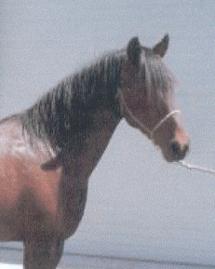
Kioraja
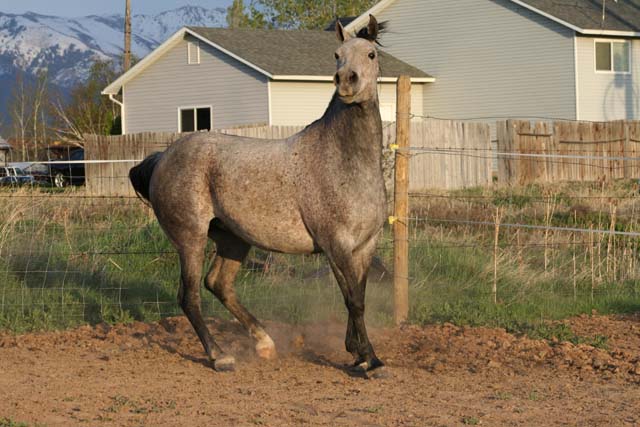
Debbani Al Hadiye
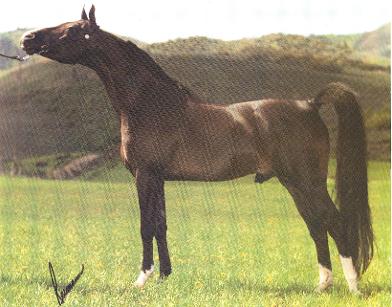
Saable
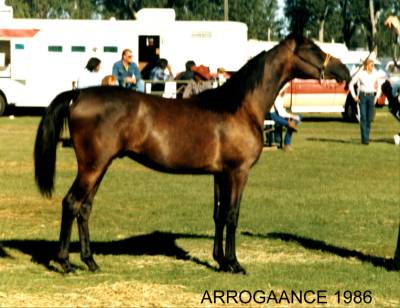
Arrogaance
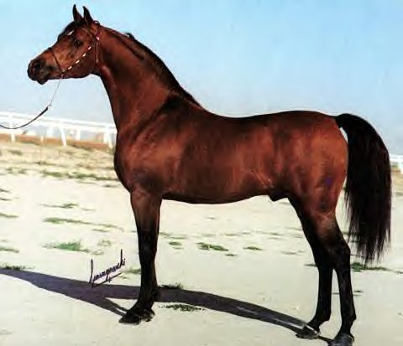
SX Saladin
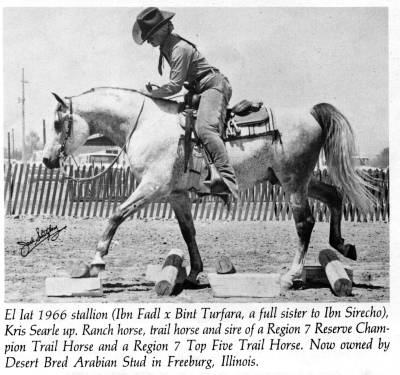
El Iat
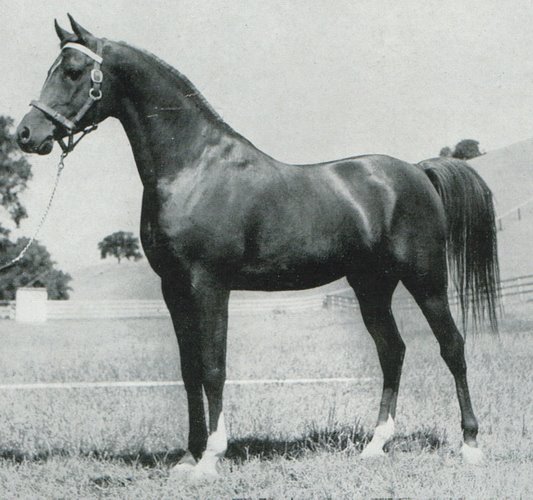
*Serafix
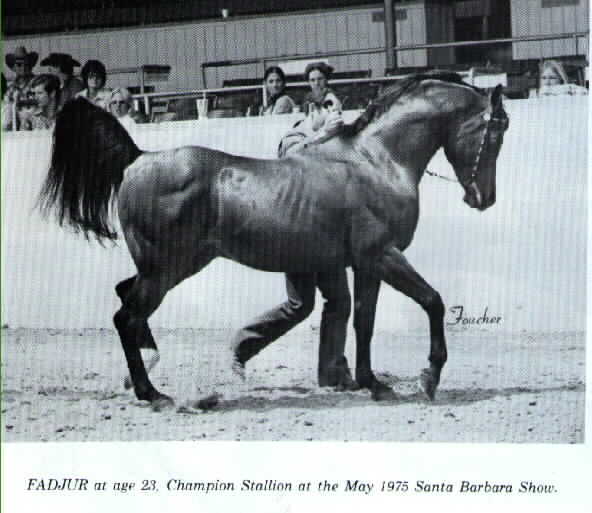
Fadjur
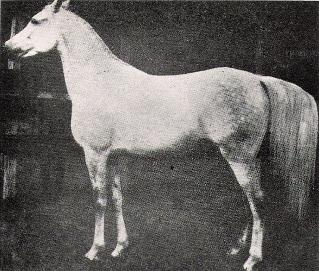
Mahroussa
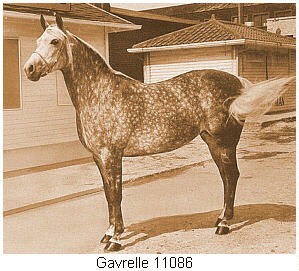
Gavrelle
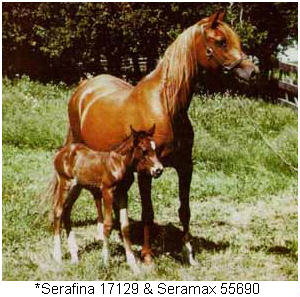
*Serafina
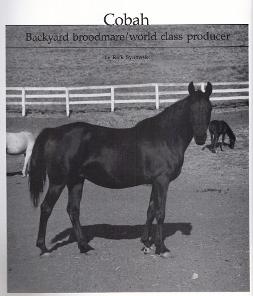
Cobah
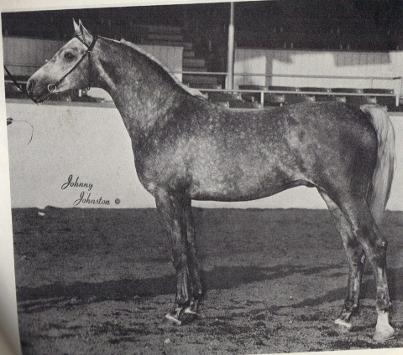
Gai-Adventure
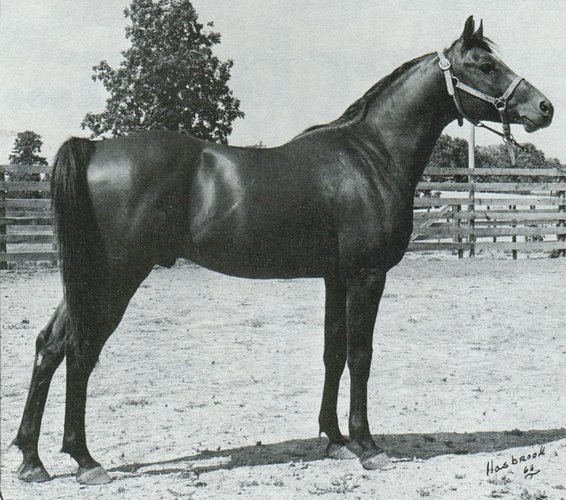
Garene
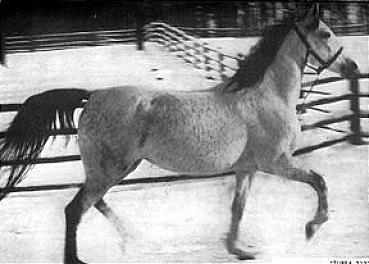
*Turfa
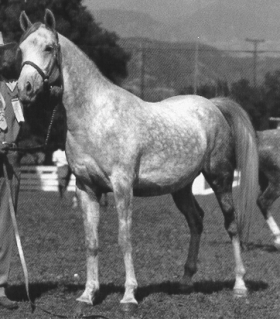
Bint Sahara
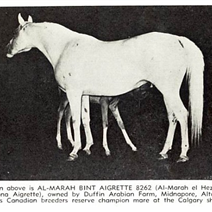
Al-Marah Bint Aigrette
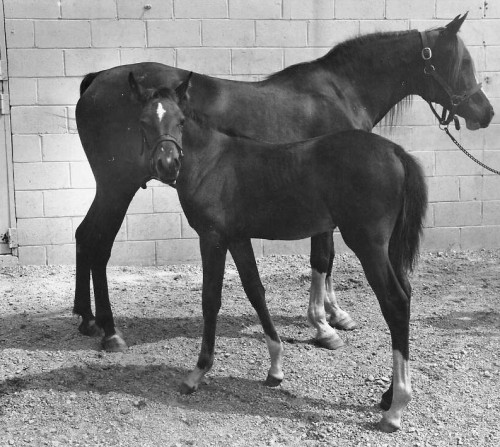
Charmeen
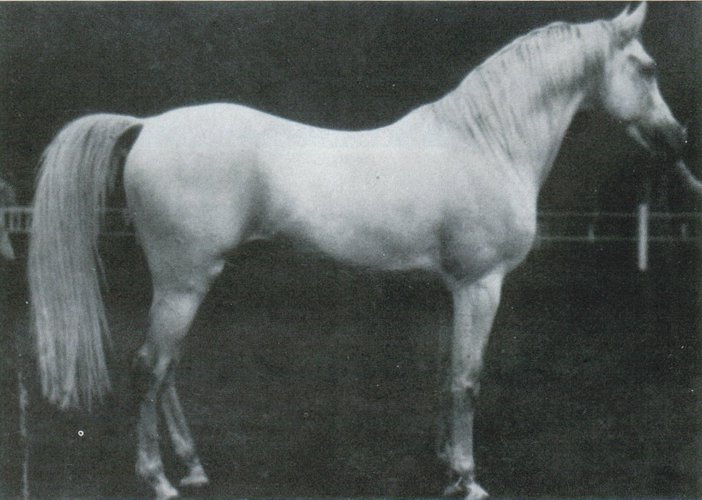
*Nasr
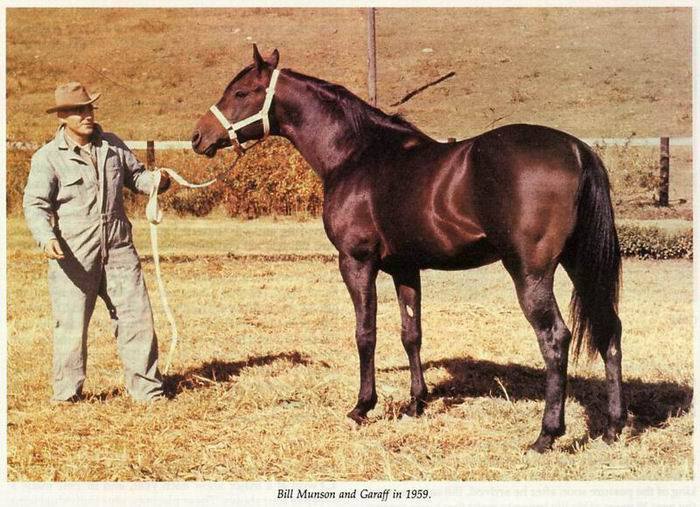
Garaff
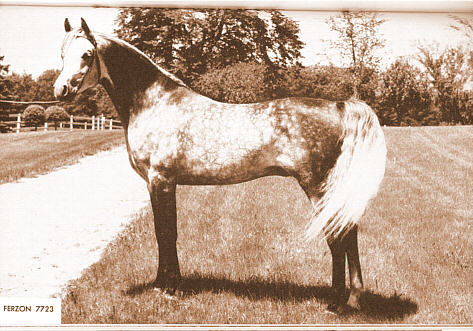
Ferzon
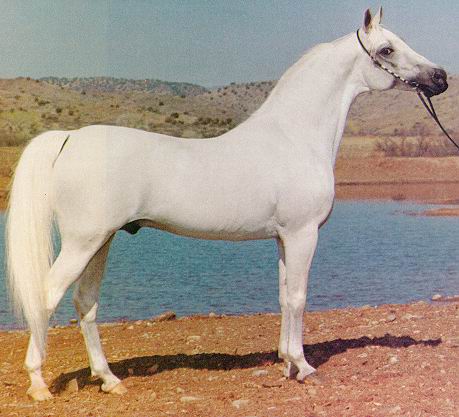
*Naborr
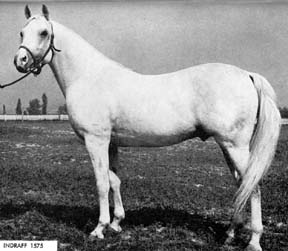
Indraff
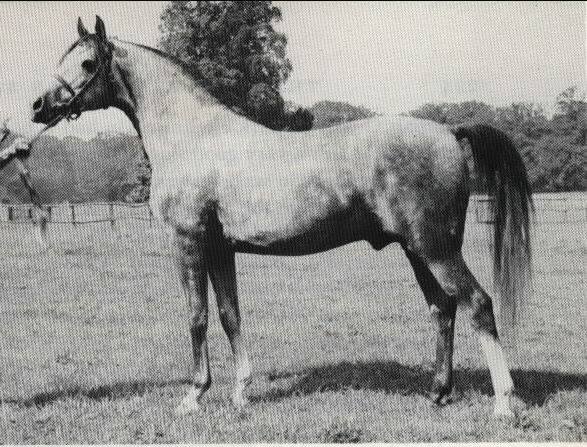
Raktha
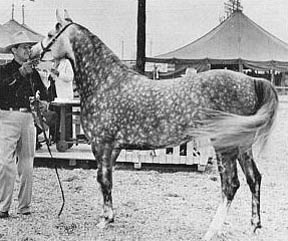
Fersara
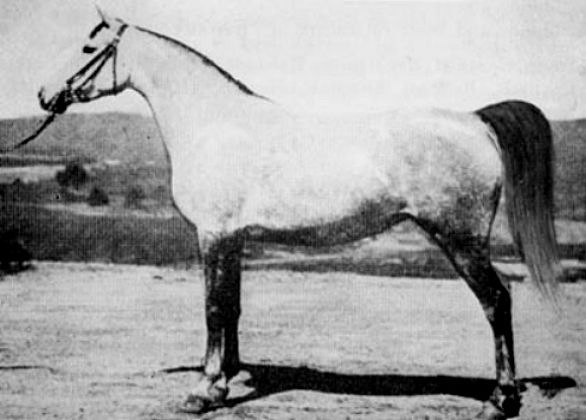
*Rossana
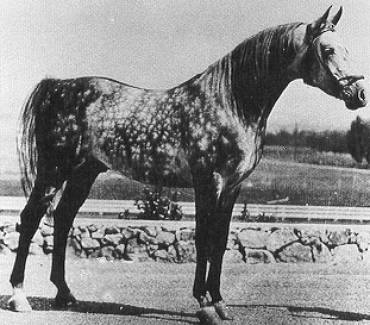
*Raseyn
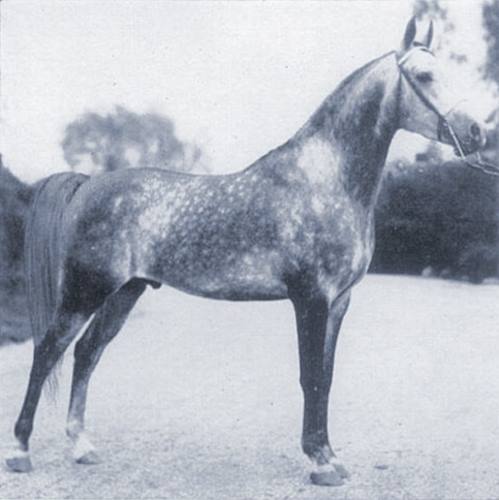
Rossdin
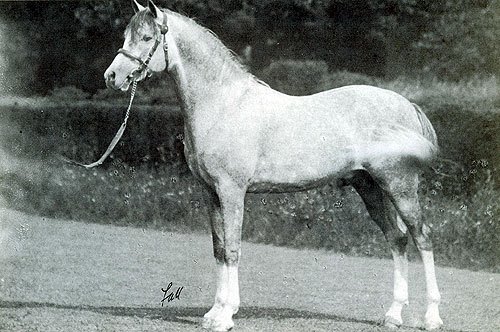
Naseem
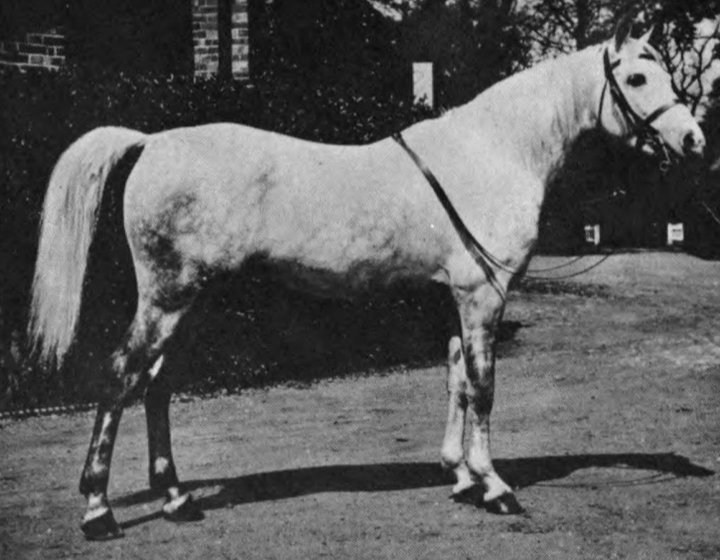
Skowronek
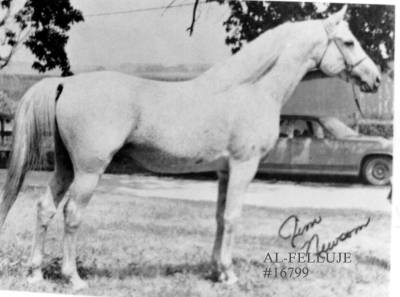
Al-Felluje
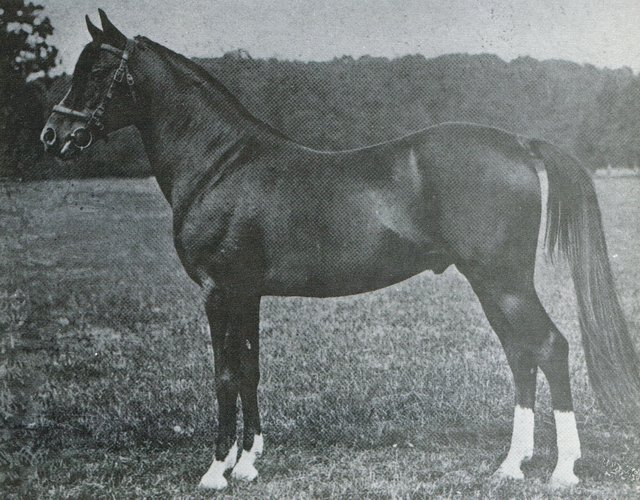
*Berk
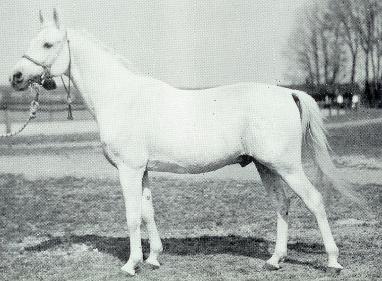
Enwer Bey
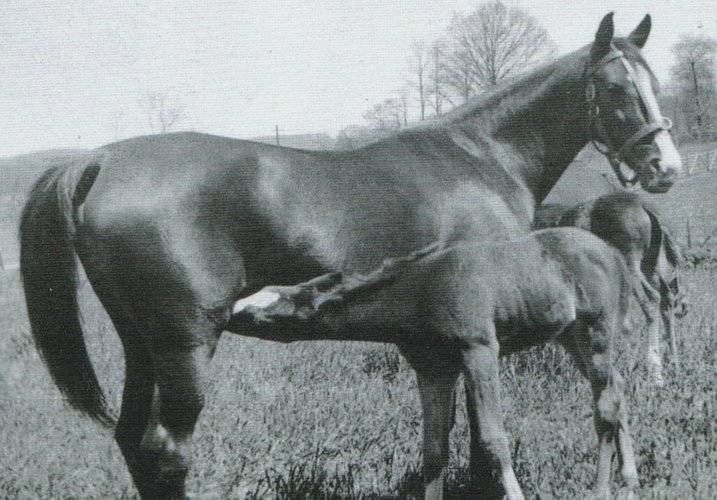
*Exochorda
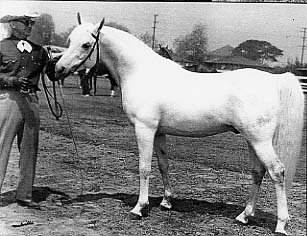
Ferneyn
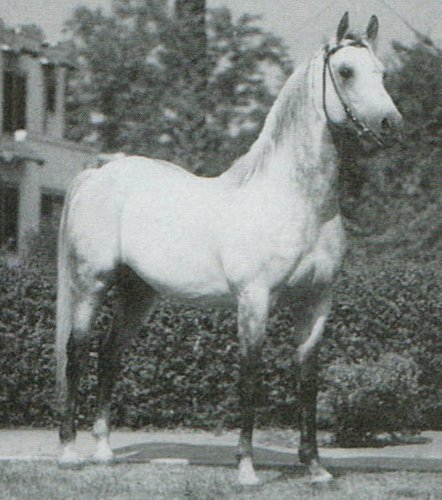
Ferseyn
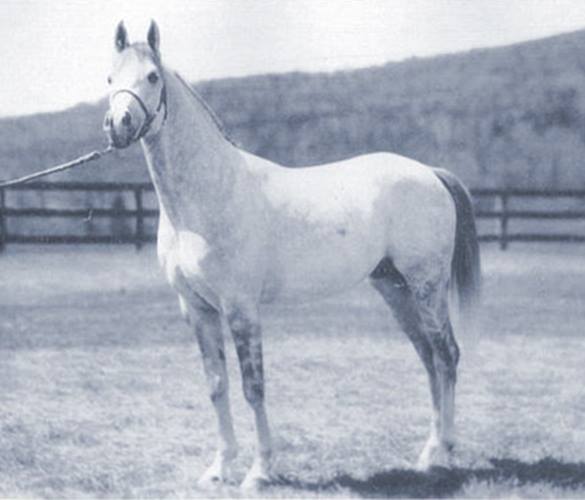
Ghazi
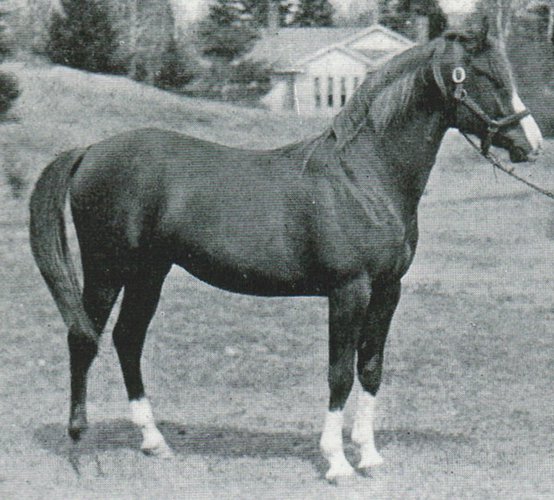
Gulastra
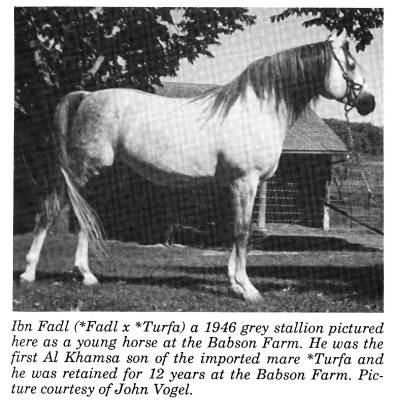
Ibn Fadl
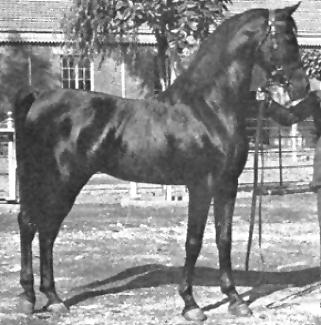
Ibn Rabdan
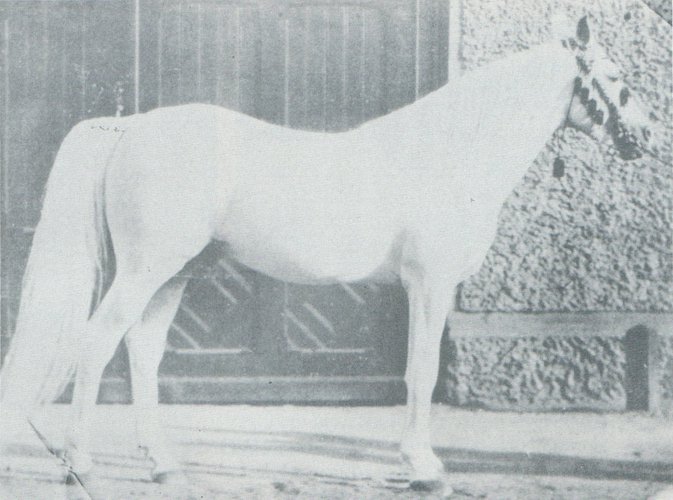
Ibrahim
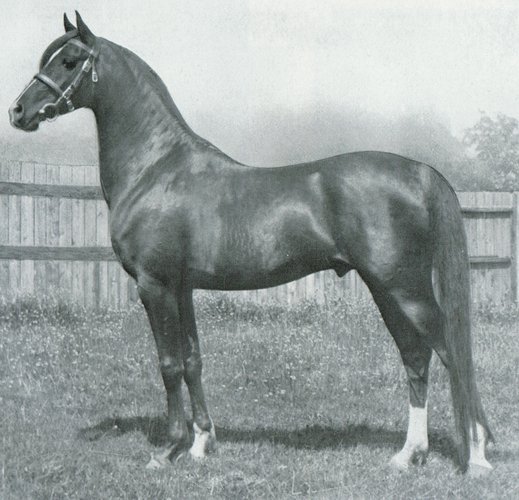
Indian Gold
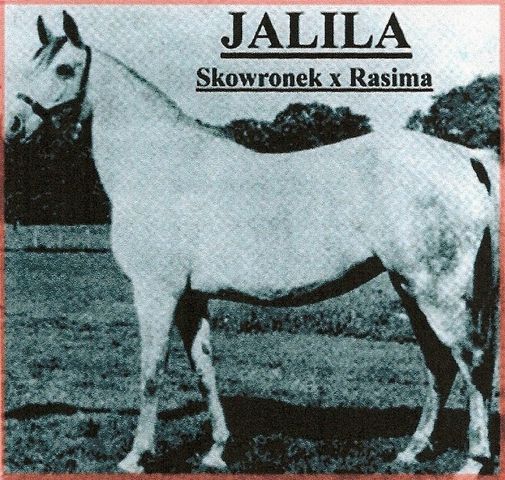
Jalila
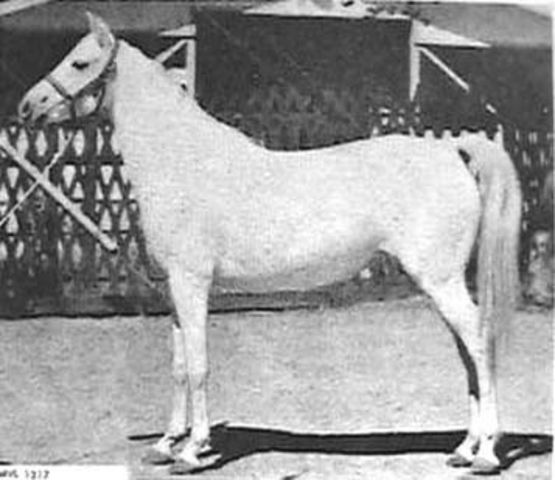
*Menfis
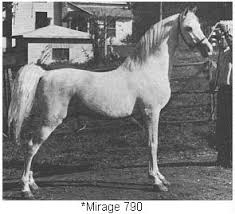
*Mirage
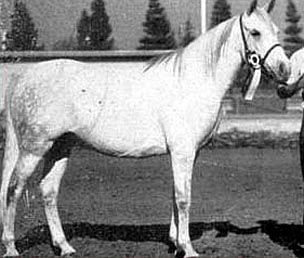
Moneyna
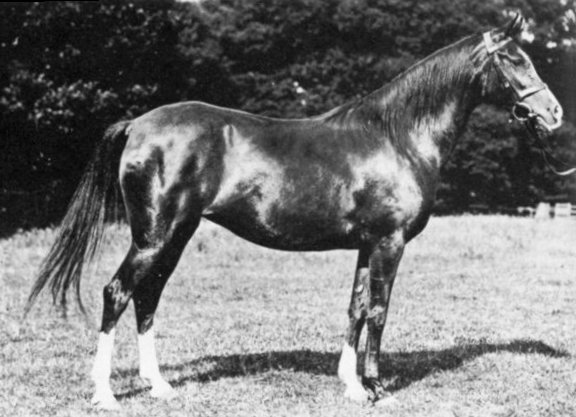
Nasra
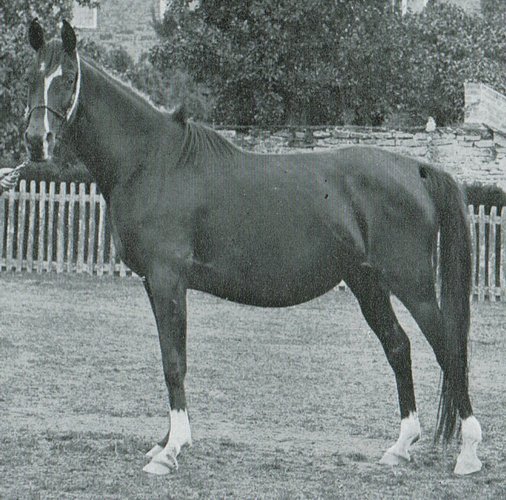
Nefisa
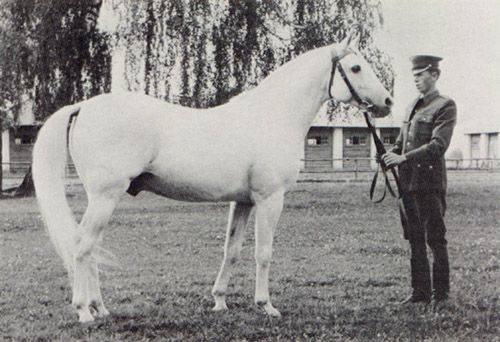
Negatiw
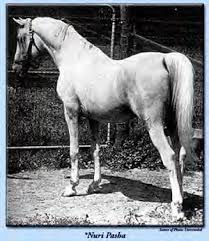
Nuri Pasha
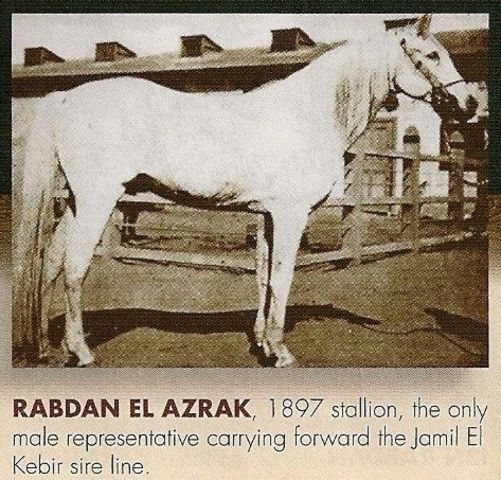
Rabdan El Azrak
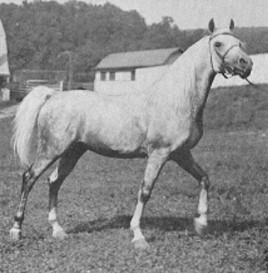
*Raffles
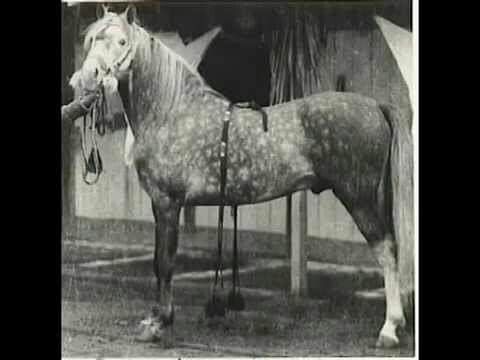
*Raswan
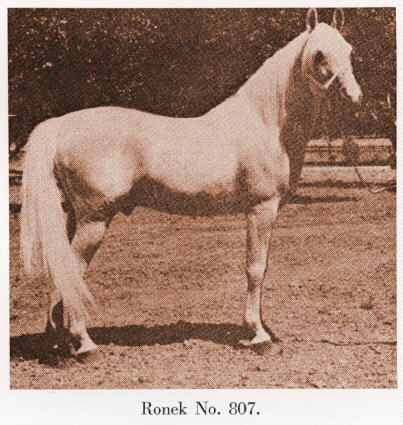
Ronek
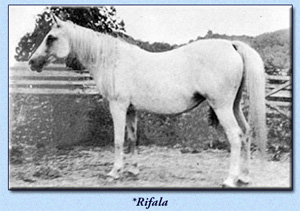
*Rifala
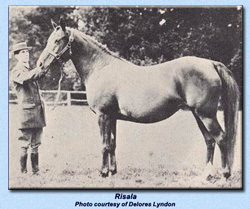
Risala
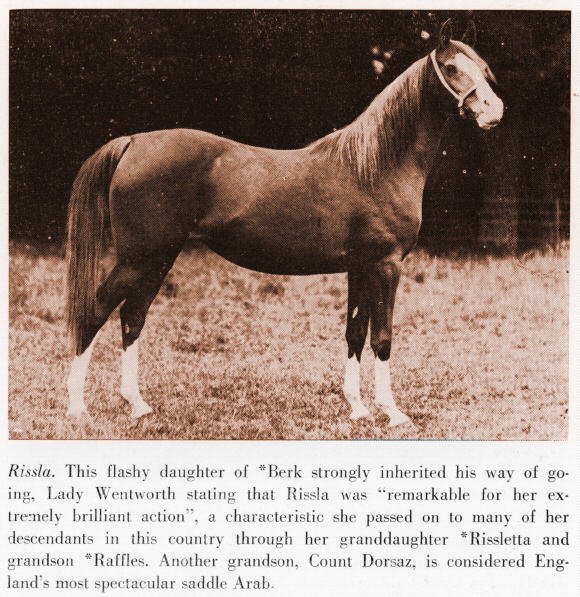
Rissla
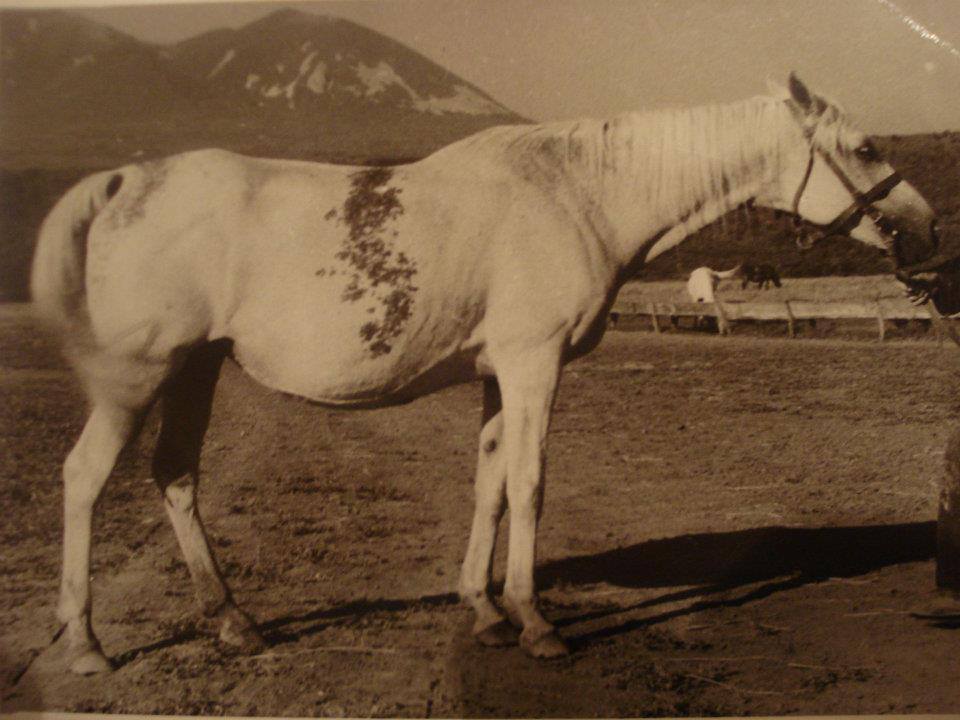
Taraszcza
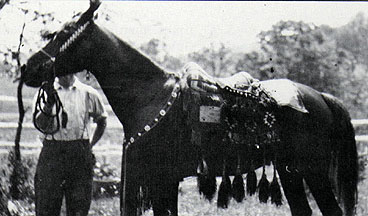
*Wadduda
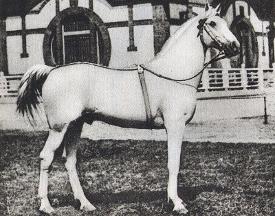
Wan Dyck
